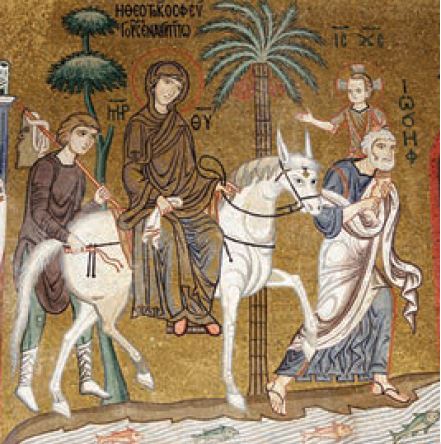Flight to Egypt
Publish date 08-03-2021
In the mosaic of the Palatine Chapel of Palermo, completed in 1130 and consecrated in 1140, we find the "flight into Egypt", next to Joseph's dream. The scene is built according to the classic scheme that depicts the Mother seated as the Mother of God on the throne, where the throne is a white donkey (color of purity). She usually has the baby in her arms. But this time he is on the shoulders of Joseph, who walks in front of her. This detail is not a mosaicist's fantasy. You have a profound significance linked to the passion and death on the cross of Jesus. In addition to the very reason for the flight, in fact - Jesus is already in danger of death - if we look carefully, some details speak for themselves. The mother is "enthroned", that is, in the position of queen, on a donkey, and is entering a "city" in Egypt, which is the land of exile: we cannot deny the analogy with Jesus that on of a donkey enters Jerusalem acclaimed as king a few days before his passion.
Then, significant is the white handkerchief in the hand of her Mother: it is the same that we find in her hands, certainly wet with tears, under the cross. And in both cases it is a strong reference both to the white cloths that wrap the baby in the manger, and to the loincloth of Jesus on the cross and to the white cloths with which his dead body is wrapped, the same ones that will remain , empty, in the open tomb. As if to say that she is present from the beginning to the end of her earthly life, especially in the most painful moments. She is always with him, physically and also, in spiritual unity, when the will of the Father seems to separate them. Even when she herself condescends to deliver him, together with the Father, into the hands of men. The same gesture you made here: she does not hold him in her arms, but she entrusts him, "hands" him over to Joseph, who becomes the image of humanity. Perhaps we can say that the "passion" of her mother has already begun. And while Joseph looks forward and lovingly carries out his task of guardian of these two precious people, Jesus turns back and looks at her, points to her, as the one who, just like him, for our love, obeys in everything. to the will of the Father, at the cost of depriving himself of his own beloved son.
There is yet another reference to passion: the baby's leg in Giuseppe's hands is uncovered, naked. When the bare legs of the baby Jesus are seen in the icons, it is a declared reminder of the stripping of him on the cross.
A careful reading then can transform in our eyes an image that seems almost an idyllic picture, into a parable of life, love, joy, trust but also pain, always present in the life of this holy family. . But a pain that has never stopped them, has never discouraged them, nor induced them to doubt that it was always God's love that guided their life, their history. A sacred pain, which they knew would be salvation for many, perhaps for everyone. Merry Christmas.
Chiara Dal Corso
NP dicembre 2020








